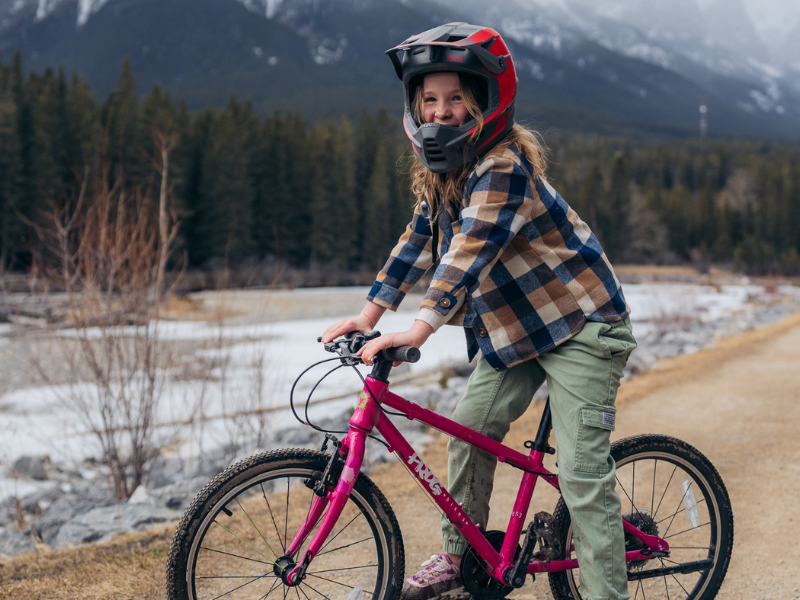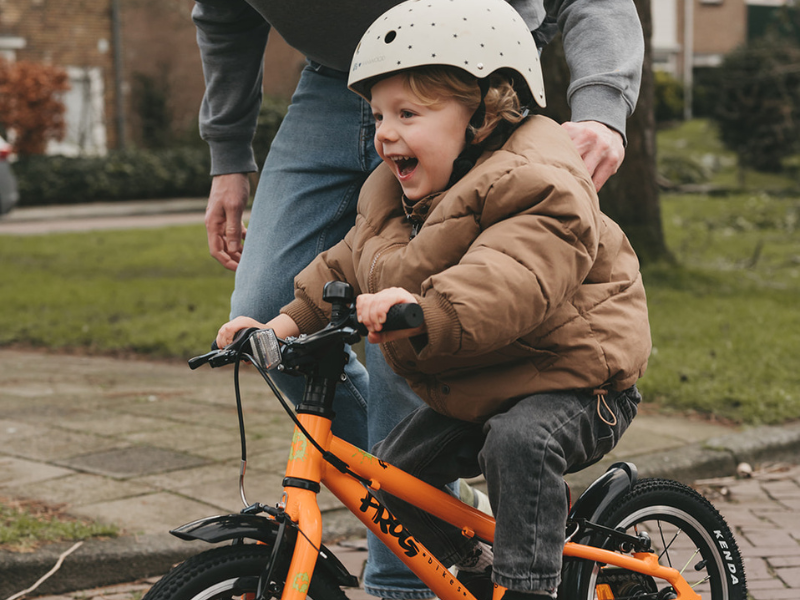How do I choose a kids full-face helmet?
- 22 Nov 2019

Choosing a full-face bike helmet for your child
Finding a kids bike helmet can be challenging, there are more full-face models on the market than in previous years but they are still not as readily available as standard helmets. There are 3 main aspects to consider and these are SIZE, WEIGHT and SAFETY CERTIFICATIONS.
Kids helmet sizing
To find out how to measure your child to ensure the helmet fits properly take a look below
To make sure the helmet will fit you will need to measure the circumference of your child’s head. Like buying a kid's bike don’t be tempted to buy something a little bigger that they can grow into. An ill-fitting helmet is not safe, it will not provide the protection required and may end up causing more damage than it prevents. Think like Goldilocks, you are looking for a snug-fitting bicycle helmet, not too tight and not too loose!
Steeper terrain, technical trails or even a stray rock and a big gust of wind can cause you to come off your bike so it’s easy to see why helmets are worn by most riders both on and off-road.
How to measure a child for a bike helmet
All you need to do this accurately is a cloth measuring tape or piece of string. Simply measure around your child’s forehead, just above the eyebrows. Do this by placing the tape measure or string on the centre of their forehead and wrapping it around their head above the ears. We would recommend doing this a couple of times to ensure you have the right measurement, a wiggling kid can throw off the measurements without you realising!
We’re a big fan of Two Wheeling Tots' infographic for those of you that prefer something a little more visual.
You can then compare this measurement to the helmet manufacturer’s sizing table and pick the appropriately sized helmet for your child. As most manufacturers list their sizes in centimetres be sure to measure in cm or convert the measurement to cm afterwards.


If you are buying the helmet as a surprise or gift and are unable to physically measure the child you can use the table shown for a basic guideline. Please be aware that this is only a guideline and nothing trumps actually measuring your child’s head for accurate sizing!
When looking at helmets don’t forget to check the inside - well-made helmets allow you to adjust the circumference of the inner helmet cage so that it cradles the head comfortably. There should be foam or gel pads evenly spaced around the inside of the helmet spreading the weight and pressure evenly around the head.
When you have your kid's full-face helmet make sure you try it on to be certain of the correct fit.


Check the helmet isn't too heavy
It may narrow the options available but we thoroughly recommend looking at child-specific helmets when choosing the best option. Many full-face helmets may fit your child (especially older kids) in terms of their head circumference, but the weight is likely to be far too much.
Again, just like bikes weight is a massive factor. It is important to realise a heavy helmet will be uncomfortable to wear and ultimately result in less enjoyment which is definitely not what we want! An adult full-face helmet is typically around 1.5kg in weight which is far too heavy for smaller children whose bodies are still growing and developing and may result in straining their neck muscles.
For petite children and toddlers, weight needs to be one of the top priorities.


Safety certifications
Helmets are worn to prevent head injuries so it’s good practice to ensure that any safety equipment is certified. That way you can be sure it will provide the protection to your child’s head that is required. There is not actually a law prohibiting the sale of helmets that don’t conform to any standards, so do be careful of lower-priced helmets that have no safety information on their box.
For bike helmets sold in the UK look out for the British Standard Certificate - this will be shown with a BS Kitemark. For European Standards, the safety marking will be displayed using the CE mark. The most common British Standard mark is BSEN1078, however, if you find a helmet with a Snell Foundation B90 (or higher) sticker then this is an even stronger standard. The European equivalent is CE EN1078. Do bear in mind these certifications are given on the standards set for everyday bike helmets, there is not currently an MTB or full-face specific safety certification in the UK or Europe.
You can find more information on helmet safety standards HERE.
Additional kid's bike helmet considerations
If you are unfamiliar with bike helmets then do take a second to look at the diagram here.
The extra considerations will make a little more sense and it will help you to decide if they are necessary or not for your little rider.


Riding style
The best question to ask yourself here is ‘why does my child need a full-face helmet?’ Are they spending a lot of time in bike parks desperate to become the next downhill superstar or are they just crash-prone toddlers? How you answer this can dictate what helmet you choose.
Ventilation
We all know that you lose a lot of heat through your head. This is increased when exercising so a helmet needs to allow the heat to escape and keep the head cool when riding. It doesn’t mean that the whole helmet needs to be covered in vents, just make sure there is ventilation at the front and back, spaced evenly to allow the air to channel out efficiently.
Colour
We know this is low down on a parents list but it’s always good to remember that for many kids colour is the MOST important factor. You might buy the best helmet you can find but if it doesn’t match their bike or their mood then you might have trouble getting your child to wear it!
Added extras
Little additional features that you might want to consider and look out for are:
- A removable chin bar - so you can transform the helmet into a standard one and save purchasing 2 different helmets for ripping up the bike park and cruising on family rides
- Adjustable visor - this allows for maximum visibility when riding which will definitely help prevent any unnecessary spills. It can also allow for somewhere to stash their goggles when they’re not wearing them
- Camera mount - for any Go Pro dudes who like to record their shredding time this will be a very important factor!
- Extra padding - for tiny heads or those that just like a little more comfort when they’re riding it might be worth looking out for helmets that offer additional padding that can be added
We quizzed the Dirts Sisters of Shred, Eme and Mia (and Dad Russell) about their choice of Full Face helmet and what is important to them.
Both Eme and Mia wear Fox Proframe helmets (one of which used to be Dad's)! The best thing they have found about this helmet is that, as well as being light, it's super easy to change the inner pads and therefore can be adapted as they grow. Both girls use the same size helmet but with different size pads. Mia's helmet has also been adapted to take various GoPro mounts for filming.
Mia told us she wears her full-face helmet because "It protects my face if I come off, it looks cool, it looks professional and I get squidgy cheeks and look like a squirrel!" They seem like pretty good reasons to us - especially the last one!


Brands offering kid-specific full-face helmets
Technological advancements in helmet construction have enabled many manufacturers to produce helmets that are stronger and lighter than ever before and many are now entering the kids’ helmet market.
We have reached out to the Frog Community to find out what helmets they have chosen to offer you a range of suitable options depending on where your child is riding.
Best full-face helmets for toddlers and pre-schoolers
- Kiddimoto IKON - suitable for ages 2 and up with adjustable padding, removable chin guard, 12 vents and all this weighing in at only 270g!! Check it out here
- Bell Sanction - fits heads from 52-60cm. Excellent head and face protection but some have found it a little on the heavy side at 950g
- 7ipd Youth M1 - certified for DH and BMX and the Youth medium fits heads as small as 48cm!
Best full-face helmets for entry-level MTBers
- Bell Super3R - well-ventilated and light (784g) this helmet is also specced with an adjustable goggle visor and camera mount
- Six Six One Reset - Lightweight with large vents and certified with CE EN1078 standard this is great for the entry-level rider. The smallest XXS version fits heads sized 49-51cm and reportedly comes in at 930g
- IXS XACT - meeting both the European EN1078 and the more stringent American ASTM DH and C.P.S.C standards, the XACT is available for mini shredders in an XS youth option for heads sized 49-52 cm.
Best full-face helmet for BMX and downhillers
- Giro Switchblade MIPS - for older kids doing bigger jumps the small (51-55cm) is a DH-certified helmet both with and without the chin bar
- 100% Status - Ultralight comes in youth sizes too - the smallest fitting heads of 48cm and the range of colours is enough to win us over!
- Bell Super DH MIPS - Well-vented and lightweight for a certified downhill helmet at only 850g
There are of course more options out there and if you are unsure about choosing a helmet for your child then just take a trip to your local bike shop. There are always staff members on hand who can help you decide on the best helmet for you.
The decision is yours, will you go full-face or not for your child’s next bike helmet? Either way, we hope our posts have given you a little food for thought!
Happy riding everyone!







